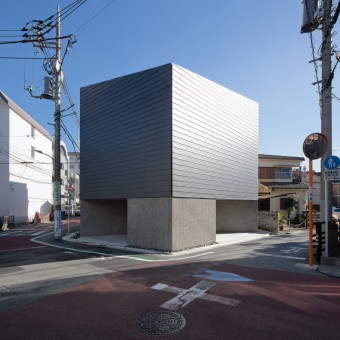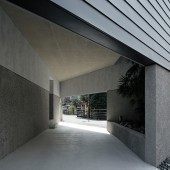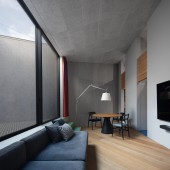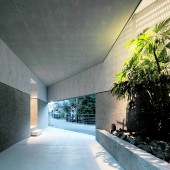Murakoshi House by Hiroki Watanabe |
Home > Winners > #147063 |
 |
|
||||
| DESIGN DETAILS | |||||
| DESIGN NAME: Murakoshi PRIMARY FUNCTION: House INSPIRATION: Safety and Comfort from Openness. The site is a pentagonal shaped site facing a three-way street with a lot of pedestrian and vehicular traffic, and adjacent to a waterway that was predicted to flood, making it a complex intersection of various elements. Therefore, we created a three-dimensional openness to the elements of light, wind, people, cars, and water that surround the site, allowing light and wind to flow into the interior and creating an architecture that dodges water while considering convenience for people and cars. UNIQUE PROPERTIES / PROJECT DESCRIPTION: An urban house integrating flood waters into its design. The house, with its drive-through garage using a high foundation and monolithic facade that takes into account sight lines and sound, was designed to achieve safety and comfort for the client while creating a duality of open public and introverted private living spaces that maintain an appropriate sense of distance from the surrounding environment. This work explores a simple, yet make sense, future urban housing with an eye toward natural disasters. OPERATION / FLOW / INTERACTION: Murakoshi House faced the challenge of how to create a safe and comfortable place to live, given its low elevation, the risk of flooding in the valley, and the densely populated surrounding area. In addition, taking into consideration the effects of recent climate change and rising electricity costs, the key point was how to create comfort, and architectural innovations and facilities were planned to withstand these factors. PROJECT DURATION AND LOCATION: The design period for the Murakoshi House is six months, from November 2020 to April 2021. The construction period is seven months, from May 2021 to December 2021. The planned site is located in Ota Ward, Tokyo, Japan. It is located on the bottom of a mortar-shaped valley that stretches to the south of Senzoku Ike Pond. FITS BEST INTO CATEGORY: Architecture, Building and Structure Design |
PRODUCTION / REALIZATION TECHNOLOGY: In order to maximize the building-to-land ratio, a pentagonal plan configuration was chosen to match the site shape, and the cross-sectional configuration of the second floor and loft was selected in consideration of height restrictions, fire prevention regulations, and structural planning. To minimize the impact on the building in the event of flooding, the first floor was planned with a high foundation. The space was designed to make the most of the site conditions. SPECIFICATIONS / TECHNICAL PROPERTIES: The building use is a private residence for a couple. The construction type is new construction. The structure is wooden, two stories above ground with a high foundation and a loft. The site area is 73.92m2 and the total floor area is 81.73m2. TAGS: House, Urban, Flood waters, High foundation, Openness, Safety RESEARCH ABSTRACT: In order to reduce running costs and the burden on the global environment, the insulation performance was set to a high level (insulation grade 6), and a level of almost no heating was implemented even in winter by minimizing the number of windows, using a Ua value of 0.37, using heat exchange ductless ventilation, and thorough air sealing measures. CHALLENGE: The Murakoshi House faced the challenge of how to create a safe and comfortable place to live, given its low elevation, the risk of flooding due to its location in a valley, and the dense surrounding area. Considering the effects of recent climate change and rising electricity costs, the key point was how to create comfort, and architectural innovations and facilities were planned to withstand these factors. ADDED DATE: 2022-12-24 18:04:52 TEAM MEMBERS (1) : IMAGE CREDITS: Image #1: Photographer Yasutaka Kojima, Variations, 2022. Image #2: Photographer Koichi Torimura, Variations, 2022. Image #3: Photographer Yasutaka Kojima, Variations, 2022. Image #4: Photographer Yasutaka Kojima, Variations, 2022. Image #5: Photographer Koichi Torimura, Variations, 2022. |
||||
| Visit the following page to learn more: http://bit.ly/3EojQz0 | |||||
| AWARD DETAILS | |
 |
Murakoshi House by Hiroki Watanabe is Winner in Architecture, Building and Structure Design Category, 2022 - 2023.· Read the interview with designer Hiroki Watanabe for design Murakoshi here.· Press Members: Login or Register to request an exclusive interview with Hiroki Watanabe. · Click here to register inorder to view the profile and other works by Hiroki Watanabe. |
| SOCIAL |
| + Add to Likes / Favorites | Send to My Email | Comment | Testimonials | View Press-Release | Press Kit | Translations |
Did you like Hiroki Watanabe's Architecture Design?
You will most likely enjoy other award winning architecture design as well.
Click here to view more Award Winning Architecture Design.








